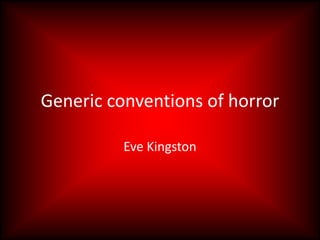
Semantics and syntactics
- 1. Generic conventions of horror Eve Kingston
- 2. Semantics • In a horror, generally there are stereotypical characters included, normally there is a protagonist which is the innocent character, usually a normal person with nothing ‘different’ or ‘supernatural’ about them. Also there is generally an antagonist which is the opposite of the protagonist, this is usually the character that is hurting or trying to plot revenge against the protagonist. They are usually a stereotypically ‘creepy’ character such as a ghost, zombie etc. Usually in a horror film there is a character included that is generally the friend of the protagonist, they usually appear during the film to support the protagonist. • Stereotypical props are normally used in a horror film such as weapons that the antagonist uses to threaten the protagonist. These are usually props such as knives and hammers. • Costume is usually connected to who the character is, the antagonist usually wears very dark clothing and they sometimes wear masks so the audience are unaware of there true appearance, which gives the film an eerie and spooky feel. The protagonist also fears the unknown when it comes to the disguise of the antagonist. • Normally, locations in a horror are very iconic, such as dark places with very little or no other people or life, and a small amount of a sound. Also large amounts of sound are often used in a very sudden way unexpectedly which would probably scare the audience and usually the protagonist. • The editing in a horror film is usually very fast pace, just before the loud sudden sounds occur, the pace of the action is very slow and then speeds up when the antagonist appears in the shots. There are usually lots of sudden changes in camera shots which can be edited. Also the colour is also often edited to make it darker or to create shadows.
- 3. Syntactics • Horror films usually begin in a state of equilibrium where the characters are happy and are getting on with there day to day lives. Also the antagonist generally isn’t included in the beginning of the film but appears when the complicating action occurs. The complicating action is usually what changes the film and creates a state of disequilibrium where the characters are placed in vulnerable positions and the protagonist is worrying about what events are to come. • Horror films don’t always end well, and the complicating action usually lasts for a while, sometimes it re-occurs after the protagonists believe they have solved the problem. This moves away from traditional story lines which creates tension from the audience.